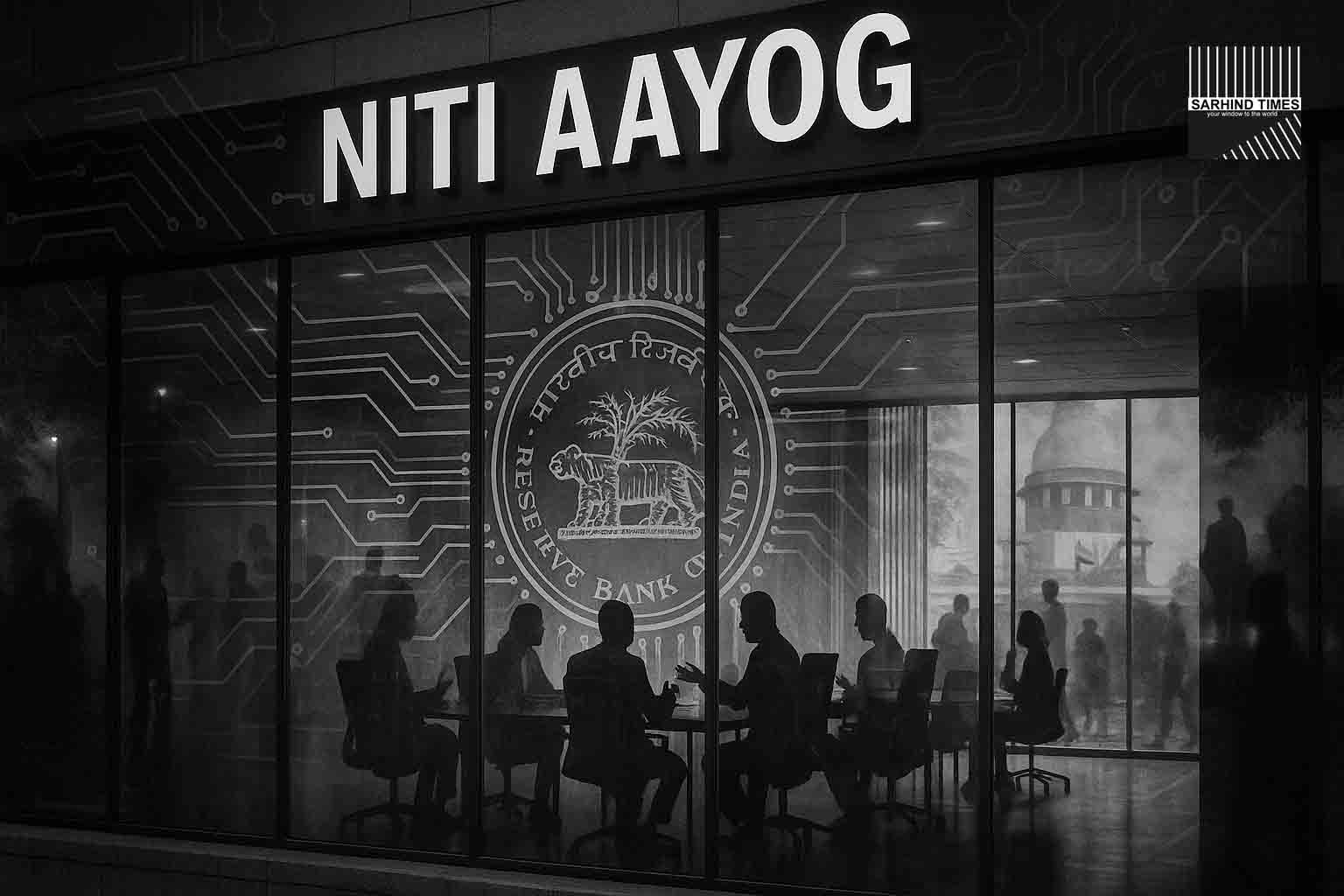A new government policy paper, “AI for Inclusive Societal Development,” outlines how artificial intelligence can uplift India’s 490 million-strong informal workforce through digital skilling, healthcare access, and equitable innovation ecosystems.
A recent policy communication from the Government of India underscores the transformative potential of artificial intelligence in driving inclusive development. The report, released by NITI Aayog in October 2025, titled “AI for Inclusive Societal Development,” proposes frameworks to integrate AI in healthcare, education, skilling, and financial inclusion, while ensuring ethical use and privacy protection. It aligns with the national IndiaAI Mission, positioning technology as a catalyst for economic inclusion and social justice. Source: Press Information Bureau.
📍 New Delhi, October 13 — AI With a Human Touch
In a significant stride toward embedding technology in governance, the NITI Aayog has unveiled a detailed roadmap titled “AI for Inclusive Societal Development.” The report, published in October 2025, builds upon India’s growing reputation as a global leader in responsible artificial intelligence, shifting focus from innovation in labs to impact in livelihoods.
The 120-page document emphasizes that India’s next leap in digital transformation must not be confined to urban tech corridors — it must empower the 490 million citizens working in the informal sector, who remain the backbone of the country’s economy.
“AI should not just make systems smarter; it should make societies fairer,”
— the report notes in its preface, authored by Dr. Suman Bery, Vice-Chairman, NITI Aayog.
🤖 The Vision: AI for Everyone, Everywhere
At its core, the report seeks to position artificial intelligence (AI) as a public good — one that complements human capability instead of replacing it.
The key framing concept, “AI for Inclusive Societal Development (AI4ISD),” lays out actionable pathways for:
- Healthcare accessibility: AI-driven early diagnosis for underserved populations.
- Education and skilling: Adaptive learning and vernacular e-content for rural learners.
- Financial inclusion: AI-enabled credit scoring for microentrepreneurs.
- Agriculture: Predictive analytics for weather, soil, and crop advisory.
- Public service delivery: Smart grievance redressal and identity authentication.
Each chapter connects technological deployment with social outcomes, linking policy aspirations to tangible field use-cases.
📊 The Context: India’s AI Moment
India’s AI ecosystem is already valued at $7.5 billion, projected to grow to $23 billion by 2027.
The IndiaAI Mission, launched earlier this year under the Ministry of Electronics and IT (MeitY), has laid the groundwork for a national AI infrastructure — including compute clusters, datasets, and startup grants.
The NITI Aayog report builds on this foundation, emphasizing “equitable diffusion” — ensuring that AI’s benefits extend beyond metropolitan innovation hubs to reach India’s Tier-2 and Tier-3 cities, rural enterprises, and informal sectors.
“India must pioneer an AI model rooted in inclusion and ethics — not just efficiency,”
— said Rajeev Chandrasekhar, Minister of State for Electronics & IT, responding to the report’s release.
💼 AI for the Informal Workforce
The report dedicates a full section to India’s informal economy, which contributes nearly 50% of GDP yet remains digitally underrepresented.
From small vendors to artisans and construction workers, the paper proposes AI-assisted skilling and market integration as transformative tools.
Key recommendations include:
- AI-led micro-skilling platforms using voice and regional languages.
- Skill-gap heatmaps to guide local training programs.
- Chatbot-based job matching systems for blue-collar workers.
- Predictive analytics for safety compliance in construction and logistics sectors.
“Empowering the informal workforce through AI is not automation — it is augmentation,”
— said Dr. Anjali Sharma, Lead Economist at NITI Aayog.
The report also calls for partnerships with state governments, NGOs, and private enterprises to pilot AI solutions tailored for region-specific economies such as textiles in Tamil Nadu, handlooms in Assam, and handicrafts in Rajasthan.
🏥 Health and Human Development: AI at the Frontlines
One of the report’s most prominent chapters is on AI for healthcare equity.
India’s healthcare sector faces acute human resource gaps — with just one doctor per 1,457 citizens. The report suggests AI can serve as an equalizer by:
- Enabling diagnostic imaging in rural health centers.
- Supporting telemedicine triage through chat-based assistants.
- Using predictive AI to track disease outbreaks and maternal health trends.
- Facilitating drug discovery and clinical decision support through machine learning models.
Pilot projects cited include:
- Wadhwani AI’s cotton pest detection tool, repurposed for dermatology screening.
- AIIMS-Delhi’s tuberculosis triage algorithm, now adapted for remote use.
- Apollo’s predictive heart-risk model, now being tested in district hospitals.
The report also emphasizes data protection and medical ethics, recommending that AI models in healthcare remain human-supervised and adhere to India’s Digital Personal Data Protection Act, 2023.
📚 Education and Skilling: Personalized Learning Revolution
Education is another priority pillar in NITI Aayog’s framework. The report envisions AI as a teacher’s ally, not a replacement — offering personalized learning paths, real-time feedback, and local language translation.
Key initiatives highlighted:
- AI-powered adaptive testing systems integrated into the DIKSHA platform.
- NEP 2020-aligned AI literacy modules for secondary schools.
- Teacher-assist bots for rural classrooms with limited staff.
- Sign-language and text-to-speech tools for inclusive education.
The report also notes the launch of “Project VidyAI”, a NITI-led sandbox involving EdTech startups co-developing AI tools for low-bandwidth learning environments.
“True digital inclusion begins in classrooms, not boardrooms,”
— states the report’s education chapter.
💳 Financial Inclusion: Credit Access for the Unbanked
AI’s role in financial inclusion is framed as the next leap in India’s Digital India journey.
With millions of small enterprises and self-employed individuals still outside the formal credit net, NITI’s report proposes:
- AI-based alternative credit scoring using transactional and behavioral data.
- Fraud detection models for microfinance and cooperative banks.
- Voice-based fintech interfaces for low-literacy users.
- Chat-based grievance redressal in regional languages.
These initiatives tie closely with the PM Jan Dhan Yojana ecosystem, aiming to turn digital access into financial agency.
By combining UPI analytics, Aadhaar-linked identity, and AI-driven microcredit, policymakers hope to expand inclusion sustainably.
🌾 Agriculture: Data, Drones, and Decisions
Agriculture, employing nearly 42% of India’s workforce, stands to gain immensely from AI-enabled decision-making.
The report outlines several use-cases:
- AI-powered weather forecasting and pest detection to reduce crop losses.
- Yield prediction models integrated with the National e-Governance Agriculture (NeGPA) platform.
- Drone-based data collection feeding into soil health dashboards.
- Farm-to-market price optimization through predictive analytics.
One pilot cited is the Digital Crop Intelligence System (DCIS), developed in collaboration with IIT Madras, which provides real-time crop advisories in six Indian languages.
By integrating these tools into Krishi Vigyan Kendras (KVKs), NITI hopes to bridge the knowledge divide between agritech innovators and smallholders.
💡 Governance and Public Services: Smart, Secure, Scalable
Beyond sectoral interventions, the report envisions AI as a backbone of responsive governance.
It cites existing success stories such as:
- The Aarogya Setu health app during COVID-19.
- The Bhashini multilingual platform enabling real-time translation.
- The PM GatiShakti digital infrastructure grid linking logistics and transport.
Proposed expansions include:
- AI-driven grievance analysis in citizen feedback portals.
- Fraud detection systems for welfare distribution.
- Behavioral insights engines for public policy design.
The underlying philosophy is simple yet transformative — “AI should serve the last citizen first.”
🔐 Ethics, Privacy, and Accountability
Amid optimism, the report takes a sober tone on data privacy and algorithmic transparency.
It calls for:
- Mandatory bias audits of public-sector AI models.
- Inclusion of AI ethics officers in major projects.
- Enforcement of citizen consent frameworks for data usage.
- Periodic public disclosure of government AI projects.
It also aligns with India’s forthcoming National AI Ethics Guidelines, currently under consultation by MeitY.
“Ethical AI is not optional — it is existential,”
— the report emphasizes.
🏛️ Policy Linkages: The IndiaAI Mission
The NITI Aayog paper is designed to dovetail with the IndiaAI Mission, India’s flagship national program for artificial intelligence.
The Mission comprises six pillars:
- Compute Infrastructure – Building AI supercomputing capacity.
- Datasets and Quality Frameworks – Establishing public data repositories.
- AI Innovation Centres – Supporting startups and research labs.
- Skilling and Awareness – Upskilling 1 million professionals.
- Ethical and Responsible AI – Creating governance mechanisms.
- International Collaboration – Building India’s AI diplomacy footprint.
By embedding inclusion within these pillars, NITI’s report positions India not only as an AI leader, but as a moral compass in technology governance.
🌐 International Context: India as a Thought Leader
Globally, India’s stance on AI ethics has gained attention.
At the Global Partnership on AI (GPAI), India has chaired working groups on “AI and Future of Work” and “Responsible AI.”
The new report aligns India’s domestic strategy with its global leadership role — championing a model that bridges digital sovereignty, economic opportunity, and human dignity.
“Inclusive AI is India’s contribution to the world’s digital future,”
— said Amitabh Kant, G20 Sherpa, during the report’s policy briefing.
📈 Implementation Path: From Pilots to Policy
The report recommends a three-tiered implementation framework:
- National Level: Integration with Digital India programs and the IndiaAI Mission.
- State Level: Creation of AI-for-Governance Cells in each state.
- District Level: Deployment of AI pilot sandboxes focused on local issues.
It also calls for public procurement reforms, enabling government departments to onboard AI tools faster through innovation-friendly tenders.
NITI suggests that AI social impact funds and PPP models can accelerate adoption among startups focused on inclusion.
🔚 Conclusion: The Human Algorithm
In its closing section, the report reminds readers that AI’s real power lies not in code, but in compassion.
As India stands at the crossroads of digital innovation and social equity, the challenge is to ensure that machine intelligence enhances human dignity — not replaces it.
If implemented effectively, “AI for Inclusive Societal Development” could become the cornerstone of India’s next-generation welfare state — where algorithms learn not just from data, but from the moral imperatives of democracy itself.
“The future will not be human versus machine. It will be human with machine — for humanity.”
— NITI Aayog, 2025 Report.
#AI #NITIAayog #DigitalIndia #Skilling #Inclusion #TechPolicy #IndiaAIMission #SarhindTimes






















+ There are no comments
Add yours